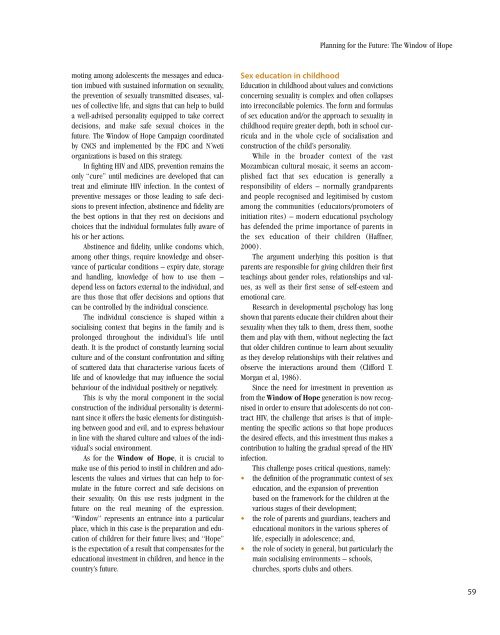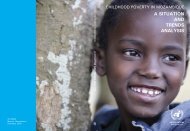English language version - Human Development Reports - United ...
English language version - Human Development Reports - United ...
English language version - Human Development Reports - United ...
- No tags were found...
You also want an ePaper? Increase the reach of your titles
YUMPU automatically turns print PDFs into web optimized ePapers that Google loves.
Planning for the Future: The Window of Hopemoting among adolescents the messages and educationimbued with sustained information on sexuality,the prevention of sexually transmitted diseases, valuesof collective life, and signs that can help to builda well-advised personality equipped to take correctdecisions, and make safe sexual choices in thefuture. The Window of Hope Campaign coordinatedby CNCS and implemented by the FDC and N´wetiorganizations is based on this strategy.In fighting HIV and AIDS, prevention remains theonly “cure” until medicines are developed that cantreat and eliminate HIV infection. In the context ofpreventive messages or those leading to safe decisionsto prevent infection, abstinence and fidelity arethe best options in that they rest on decisions andchoices that the individual formulates fully aware ofhis or her actions.Abstinence and fidelity, unlike condoms which,among other things, require knowledge and observanceof particular conditions – expiry date, storageand handling, knowledge of how to use them –depend less on factors external to the individual, andare thus those that offer decisions and options thatcan be controlled by the individual conscience.The individual conscience is shaped within asocialising context that begins in the family and isprolonged throughout the individual’s life untildeath. It is the product of constantly learning socialculture and of the constant confrontation and siftingof scattered data that characterise various facets oflife and of knowledge that may influence the socialbehaviour of the individual positively or negatively.This is why the moral component in the socialconstruction of the individual personality is determinantsince it offers the basic elements for distinguishingbetween good and evil, and to express behaviourin line with the shared culture and values of the individual’ssocial environment.As for the Window of Hope, it is crucial tomake use of this period to instil in children and adolescentsthe values and virtues that can help to formulatein the future correct and safe decisions ontheir sexuality. On this use rests judgment in thefuture on the real meaning of the expression.“Window” represents an entrance into a particularplace, which in this case is the preparation and educationof children for their future lives; and “Hope”is the expectation of a result that compensates for theeducational investment in children, and hence in thecountry’s future.Sex education in childhoodEducation in childhood about values and convictionsconcerning sexuality is complex and often collapsesinto irreconcilable polemics. The form and formulasof sex education and/or the approach to sexuality inchildhood require greater depth, both in school curriculaand in the whole cycle of socialisation andconstruction of the child’s personality.While in the broader context of the vastMozambican cultural mosaic, it seems an accomplishedfact that sex education is generally aresponsibility of elders – normally grandparentsand people recognised and legitimised by customamong the communities (educators/promoters ofinitiation rites) – modern educational psychologyhas defended the prime importance of parents inthe sex education of their children (Haffner,2000).The argument underlying this position is thatparents are responsible for giving children their firstteachings about gender roles, relationships and values,as well as their first sense of self-esteem andemotional care.Research in developmental psychology has longshown that parents educate their children about theirsexuality when they talk to them, dress them, soothethem and play with them, without neglecting the factthat older children continue to learn about sexualityas they develop relationships with their relatives andobserve the interactions around them (Clifford T.Morgan et al, 1986).Since the need for investment in prevention asfrom the Window of Hope generation is now recognisedin order to ensure that adolescents do not contractHIV, the challenge that arises is that of implementingthe specific actions so that hope producesthe desired effects, and this investment thus makes acontribution to halting the gradual spread of the HIVinfection.This challenge poses critical questions, namely:• the definition of the programmatic context of sexeducation, and the expansion of preventionbased on the framework for the children at thevarious stages of their development;• the role of parents and guardians, teachers andeducational monitors in the various spheres oflife, especially in adolescence; and,• the role of society in general, but particularly themain socialising environments – schools,churches, sports clubs and others.59
















